
What are ferns?
Ferns are a very ancient family of plants: early fern fossils predate the beginning of the Mesozoic era, 360 million years ago. They are older than land animals and far older than the dinosaurs. They were thriving on Earth for two hundred million years before the flowering plants evolved.
As we know them now, most ferns are leafy plants that grow in moist areas under forest canopy. They are "vascular plants" with well-developed internal vein structures that promote the flow of water and nutrients. Unlike the other vascular plants, the flowering plants and conifers, where the adult plant grows immediately from the seed, ferns reproduce from spores and an intermediate plant stage called a gametophyte.
What makes them different from other vascular plants?
There are two answers to this.
The first is that ferns are (relatively) delicate plants that only grow in areas where there are suitably moist conditions. They favour sheltered areas under the forest canopy, along creeks and streams and other sources of permanent moisture. They cannot grow readily in hot dry areas like flowering plants and conifers.
The second explanation ties in with the first: ferns reproduce differently from the conifers and flowering plants. It all has to do with moisture. Not just the moisture that allows the plant to live where it does, but the moisture that allows it to reproduce there.
How do they reproduce?
As flowering plants are so common, we are all familiar with how they reproduce. Itís useful to look at this first, to give us something to compare to ferns. Flowering plants (and conifers) reproduce when pollen from a male flower - carried by wind, insect or other vector - fertilises the female flower. (Many flowering plants, of course, include both male and female parts in the same flower). The male pollen cell carries half the genetic material of the adult plant and fuses its genetic material with that of the female cell, which carries the other half. The complete, fertilised cell grows into the seed, which, when ripe and when it finds itself in suitable soil and moisture, is capable of producing a complete adult plant.
Higher plants have a very robust propagation system: the pollen from the male flower is very hardy, and the female flower nurtures the seed until it is ready to grow. The seeds themselves are often very durable, able to wait for long periods in adverse conditions before they grow. So the higher vascular plants have evolved to occupy nearly every niche on the land surface of the earth.
Ferns do it differently. They have a more complicated method that depends on there being liquid water for the process to complete. As a result, they can only reproduce where there is sufficient moisture: the reproduction process itself requires moisture.
So, how do they do it? To detail this, Iíll need to describe some of the parts of a fern.
Parts of the fern - and some names for them
The leafy branch of the fern is usually called a frond. The small leaflets that make up the whole frond are called pinnae.
If you look underneath a fern frond, you will often see small clumps, spots or patches that look like they are stuck onto the under surface of the pinnae. These patches are where you find the spores. The spores grow inside casings called sporangia. The sporangia may clump together into what are called sori (singular: sorus). Photo (A) below shows sporangia clumped into sori on a Kangaroo Fern frond. Sometimes these sori follow the fern leaf veins, sometimes they are set into indentations in the underside of the pinna. Not every frond has spores under it: fronds that have the spores are called fertile fronds.
Take a look more closely at the spore structures under the pinnae of a fertile frond, using a hand lens. In some cases, you will see that each is composed of myriads of smaller structures. These are the sporangia - the spore casings that hold the spores. Some ferns protect their sporangia with thin semi-transparent membranes, often globular in shape, called indusia. Inside the indusium (if there is one) there are the sporangia. Photo (B) below shows open indusia on a Soft Tree Fern frond.
Other ferns donít have the indusium, the sporangia are open to the outside world. The sporangia are usually tiny - maybe half a millimetre (one fiftieth of an inch) across. The spores of course are even smaller.
Sometimes the sporangia are tucked under a curled-over part of the margin of the pinna. Photo (C) shows this effect on the underside of a Maidenhair Fern.
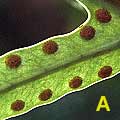
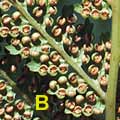
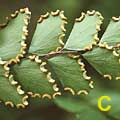
If you take a piece of mature fertile fern frond and place it face up inside a book - or on a piece of paper under a weight - so that the spore material is on the underneath of the frond , then leave it overnight, youíre likely to find the next day that the spores have been released as a fine coloured powder onto the paper. They show up as a fine pattern tracing the form of the fern frond. They can be black, brown, reddish, yellow or even green, but they are extremely small. Each of these spores is capable - through a circuitous process - of growing into an adult fern.
How do the spores grow?
If the spore finds suitable conditions, it will grow into a tiny heart-shaped plantlet called a prothallus or gametophyte. In this regard, the spore behaves quite like the seed of a higher plant, except that what grows from the seed is the full adult plant, but what grows from the spore is the gametophyte. The gametophyte is not the full fern, but a plant with only half the genetic material of the adult fern, rather like a sperm cell or an egg cell. The gametophyte is the intermediate stage from spore to adult fern.
If the gametophyte finds itself in a suitably moist place, fertilisation takes place, and it is transformed into a complete adult plant. It becomes whatís called a sporophyte. Given the right conditions, this tiny sporophyte will continue to grow into a full adult fern, where it can produce spores of its own, to repeat the life cycle.
This is how it works, in more detail:
What happens with a gametophyte can only be seen under a strong lens, as the gametophyte is small - usually less that half an inch across. The gametophyte has two sets of reproductive organs on its underside - the male parts called the antheridia, and the female parts called the archegonia. The antheridium contains sperm cells while the archegonium contains egg cells. They are each located on the gametophyte, a little separated from each other. If there is a film of moisture, the sperm cells from the antheridium swim towards the egg cells in the archegonium. This may be on the same gametophyte or an adjacent one.
When the sperm cells find the egg cells, they fuse their genetic material to make a cell with the full adult fern set of genes. This cell is the beginning of the adult fern, located in and protected by the gametophyte structure. As it grows to become the sporophyte, it takes over from the gametophyte and becomes the adult fern.
Here is a diagram that shows the fern life cycle.
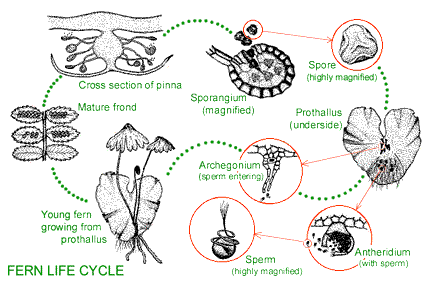
The diagram is adapted from a more detailed one on the Australian National Botanic Gardens website.
Ferns can reproduce in other
ways, too.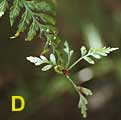 It is possible for a sporophyte to grow from the gametophyte without
fertilisation, a process known as apogamy. This can happen in
drier areas where there is insufficient water to allow normal fertilisation.
Ferns can also grow from spreading rhizomes (roots) of existing plants.
Brackens often spread this way. Or they can sprout baby ferns at the
"proliferous" tips of their fronds. When the parent frond
droops and touches the soil, the baby plant takes root on its own. Photo
(D) shows a proliferous tip on a Mother Spleenwort fern. It is
a faster method that some ferns use to reproduce mature adult plants,
in addition to normal reproduction by spores.
It is possible for a sporophyte to grow from the gametophyte without
fertilisation, a process known as apogamy. This can happen in
drier areas where there is insufficient water to allow normal fertilisation.
Ferns can also grow from spreading rhizomes (roots) of existing plants.
Brackens often spread this way. Or they can sprout baby ferns at the
"proliferous" tips of their fronds. When the parent frond
droops and touches the soil, the baby plant takes root on its own. Photo
(D) shows a proliferous tip on a Mother Spleenwort fern. It is
a faster method that some ferns use to reproduce mature adult plants,
in addition to normal reproduction by spores.
Of course, the proliferous baby plant, or the frond that grows from the spreading rhizome, is identical genetically with the plant it sprang from. Only ferns that grow from spores using normal fertilisation can take advantage of the genetic diversity offered by the full reproduction process.
What affects where ferns will grow?
There are several factors that adult ferns need to survive (ignoring pests or disease):
- moisture in the soil;
- moisture in the air;
- suitable nutrients in the soil;
- sufficient light for photosynthesis;
- suitable temperatures;
- protection from wind;
- protection from too much sunlight;
- protection from freezing; and
- dependability and continuity of the previous requirements.
Depending on the type of fern, the degree of each factor required can vary greatly.
Another factor that is less often recognised is the difference between the conditions needed for a fern to survive, and the conditions it needs to reproduce. A fern may live quite happily in a relatively hostile environment, but it may not reproduce there. You will only find ferns growing naturally in areas where, at least for some of the time, the conditions suit both survival of the adult plant and reproduction Ė which means the survival of the gametophyte. Perhaps more than any other factor, it may be the hardiness of the gametophytes that determines whether a fern will thrive naturally in an area or not.
Why do ferns grow in some places and not others, and why do some species thrive where others don't?
Like all plants, ferns have evolved to suit their environment. Some can tolerate extreme drought and heat, others only live in the deepest rainforest. You canít grow a cactus in the sub-Antarctic, though grasses will survive there. And likewise, you canít expect a tree fern to grow in a desert, though some varieties of rock fern do.
Ferns are very successful niche plants: they are well adapted to particular environmental niches - soil moisture, humidity, light, etc. They seldom grow outside these niches, some of which are very specific. For example, in our region, the Mother Spleenwort fern always grows near waterfalls.
If you want a fern to grow, you have to come to the party by creating an environment similar to the one it has evolved to live in. It involves creating the right niche for the plant. For example, in the Australian National Botanic Gardens in Canberra, there is a deep gully that is full of tree ferns and many other varieties of fern. The microclimate in the gully is kept constant by sophisticated watering systems at high humidity and with permanent soil moisture. The ferns thrive. Before the watering system was set up, this was a dry gully in dry sclerophyll eucalypt forest and grassland. At best, a few small ground ferns might have grown in the moister crevices. With the right microclimate, an entirely different set of plants can grow there. A photograph of the gully as it is now is on the ANBG site.
To paraphrase the movie, if you build it, they will thrive.
More information?
Another look at the process of fern reproduction is on the American Fern Society pages at http://amerfernsoc.org/lernfrnl.html.
More helpful information on ferns and their life cycle is on the Australian National Botanical Gardens page on propagating ferns.